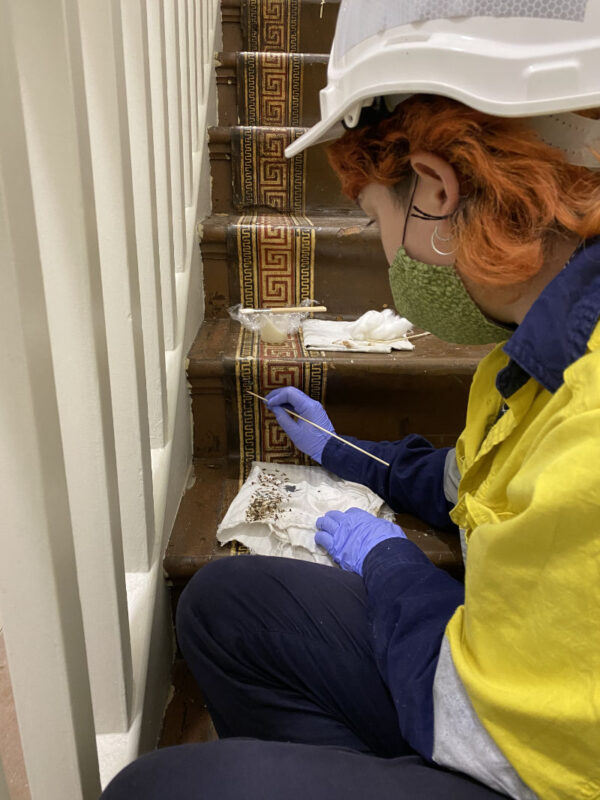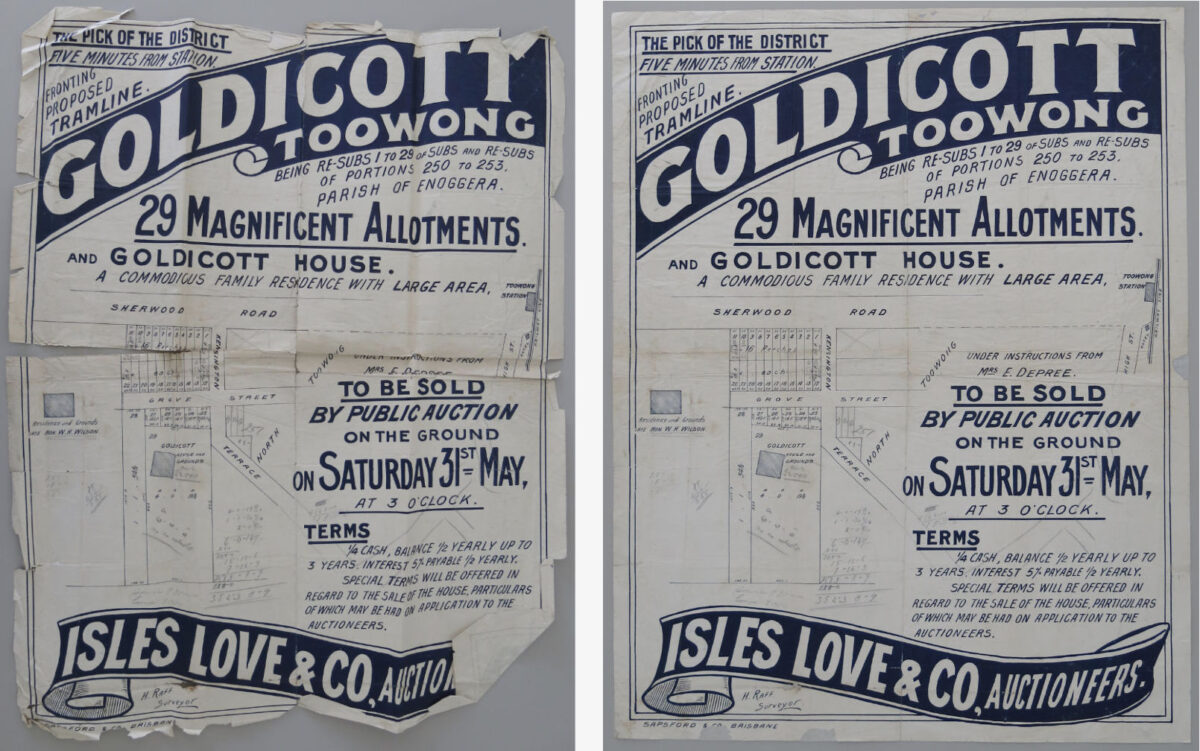The Emerging Conservators SIG launched its mentorship program in 2020, which paired students and conservators with fewer than five years in practice with more experienced members of the community. Program participants were able to approach the process in a way that suited them; some designed the mentorship around a particular treatment or project, with mentors providing valuable feedback based on time-gained knowledge. Below, some participants in the 2020 Mentorship Program reflect on their experiences: Isabelle Legg, whose mentor was objects conservator Evan Tindal; and Cody Alexander, whose mentor was paper conservator Briony Pemberton.
Hi mentor/ mentee, can you briefly introduce yourself?
Evan: Hi! I’m Evan, an objects conservator with Grimwade Conservation Services. After studying anthropology at uni and an initial trajectory towards archaeological fieldwork in the US, with a bit of luck and a lot of support I landed in art conservation. On the day-to-day I enjoy exploring new ways to solve problems, especially if they involve science and technology.
Isabelle: I’m a student at the Grimwade Centre for Cultural Materials Conservation at Melbourne Uni, specialising in objects conservation. Originally from Sydney I have a background in illustration and fine arts. I’m currently nearing the end of my degree and working part time as an art handler. In a similar way to Evan, I also love finding creative ways to problem solve, which is partly what initially attracted me to conservation.
How have you implemented the mentorship so far? Monthly catch ups? Practical work?
The mentorship centred around hands-on experience on historic linoleum flooring found in the 1888 Building on the University of Melbourne campus during renovations. Over the course of a few weeks, we worked on-site treating the linoleum, which spanned two flights of stairs. Conservation works were organised through Evan’s employment at GCS, and included all elements of the documentation and treatment stages. It was definitely a learning experience for everyone, navigating working within the parameters of a busy construction site and bringing students into a project during COVID-19. We found the mentorship was such a positive experience that we’ve continued with informal catch ups, COVID restrictions permitting.
What made you apply for the AICCM Mentorship Program?
Evan: My entry into conservation was markedly shaped by mentorship in on-the-job-training, and so I really appreciate how valuable this experience is outside the classroom. I also felt like I was at a point in my career and experience level where I could positively contribute to an early career conservator in a similar vein to my own experience.
Isabelle: As an emerging conservator, the most valuable thing for me is gaining as much and as varied experience as I can. It can be a bit tricky trying to gain hands-on experience, especially in treatment. I was really keen to extend my learning outside of the academic bubble and the mentorship provided the perfect opportunity.
What have you learned from the experience?
Evan: This experience definitely confirmed for me that anyone can offer a fresh and valuable perspective. We provided Issy with an opportunity to work on a project, but she also directly contributed to shaping our approach and methodology by leaning on her past educational and professional experience in the arts.
Isabelle: This experience definitely gave me an insight into what it can be like working on-site, something I hadn’t had the opportunity to do before. It gave me a chance to apply not just the skills but the critical reasoning I have been developing in my studies in a real-world application. I found the project to be very rewarding. I’ve also found it really encouraging to have someone like Evan in my corner. Just knowing that someone is invested in your professional development is really reassuring.

Isabelle works on-site, cleaning surface residue from historic linoleum.
Overcoming challenges and thriving during an online version of the AICCM Mentorship Program
Cody Alexander, Brisbane-based Grimwade Student
Mid 2020 was arguably not the most well-timed moment to embark on my conservation journey – but there’s never a right time to pivot your career from forensic document examination to conservation, is there? I began my studies at the University of Melbourne in the midst of travel restrictions and lockdowns. The resourcefulness and dedication of the staff at the Grimwade Centre to deliver a course that was never designed to be delivered by distance never ceases to amaze me. In the midst of my own stressors as a student I don’t think that I came to fully appreciate just how hard everyone involved has had to work until I had a moment to sit back, take a breath and reflect.
Equally, the AICCM has demonstrated ongoing support for its members through the delivery of online panels and the activities of local chapters in each state. Of the most benefit to me was AICCM’s decision to forge ahead with their 2020/21 Mentorship Program. Unable to travel to the Grimwade Centre for crucial introductions to the layout of the lab, I feared missing out on foundation skills.
The AICCM Mentorship Program offered me the chance to connect with a conservator one-on-one and learn paper conservation 101 hints and tips from my newly established at-home-studio – hurriedly put together once I realised that I would need to complete Conservation Treatment 1 from home (my first opportunity to learn the art of tear repairs and other basic skills).
I was paired with Briony Pemberton from Victoria. It was daunting to have been paired with someone so accomplished at such an early stage of my studies but Briony was so encouraging and supportive that I quickly overcame my imposter syndrome. Over Zoom, Briony and I met weekly to discuss the object I was working on, an early 20th-century real estate poster for a suburb in Brisbane. With Briony’s assistance, the project introduced me to various methods of dry surface cleaning, humidification and tear repairs. We workshopped resourceful ways of overcoming a lack of access to high-end lab equipment and introduced me to the importance of acknowledging limitations and maintaining a professional workspace when working from a home studio.
From Briony’s perspective, she says that the AICCM mentor program served to give ‘me a chance to stay connected to the conservation community throughout a somewhat isolating period of the pandemic and share my knowledge with such an enthusiastic student’.
It’s coming up to that time of the year when AICCM will be requesting expressions of interest from potential mentors and students alike for the 2021/22 Mentorship Program. Despite the very real possibility of having to complete the program online, I would encourage new students to consider giving it a go and enjoy the process of forging a supportive relationship with a professional who is ready to dedicate their precious time to developing your skills and answering your questions.
I for one am encouraged by my previous experience with Briony and am excited to see what learning experiences the 2021/22 program holds for me.
Permission to quote Briony Pemberton granted from Briony Pemberton on 16 August 2021.
Cody would also like to thank the QLD State Library for their support and guidance.

Estate map of Goldicott Toowong Estate, Toowong, Queensland, 1902. Before and after treatment.